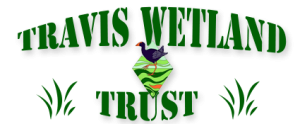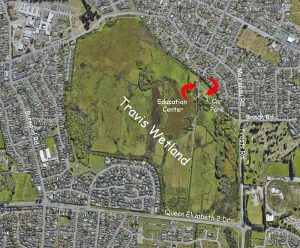 |
March 2018
Workday reminder, March 17 2018
Travis monthly workday, Saturday March 17 2018, 9 am – noon.
Meet at the education center (the old farm house) behind the Beach Rd car park at 9 am.
Bring your own gumboots but don’t worry if you don’t have any we can loan you some.
All gear provided.
There will be a morning tea afterwards for those that want to stay for a chat.
Workday Saturday 17th February
A fine morning saw 20 people turn up to assist with a variety of tasks.
First up was attacking convolvulus on both sides of the Beach Road entrance driveway.
We successfully removed most of the higher growing patches and hopefully this will reduce seed spread this season.
Our ranger John chopped down a large crack willow which was sneakily growing horizontally between flaxes.
Next stop was the ‘triangle area’ which is a small patch of planting near the entrance to the bird hide walk.
On the outside this area looked like a poster advert for native planting.
However small clearings further in revealed a surprising array of large weeds such as hemlock, elderberry and nightshade. These were soon sent packing by a small team of warriors.
Meanwhile, another team was working hard releasing plants in the Millennium planting area near the bird hide. Grass always grows strongly in this area and convolvulus was encroaching too.
Colin Meurck was on hand to show us examples of totara, matai and pokaka trees fruiting in the Millennium planting plot.
The pokaka had large green fruit that were easy to spot and these will turn a blue colour as they ripen.
Tiny totara seedlings were beginning to grow under one of the parent trees.
Cool drinks and a shared lunch were gratefully consumed to complete a productive morning.
Thanks everyone
Article: Sue Britain
Stick Insects (Phasmatodea)
 |
||
Smooth Stick Insect ( Clitarchus hookeri )Phasmatodea are found in all continents except Antarctica, but they are most abundant in the tropics and subtropics. |
||
Shield Bugs ( Pentatomidae )
With all the media attention on the Brown Marmorated Stink Bug at present I thought it might be time to show a couple of members of the family that live at Travis.
There are roughly 7000 species of Pentatomoidea worldwide and they are divided into 14 or 15 families.
Really good info and pictures of the species below can be found in Landcare factsheets
Pittosporum shield bug – Monteithiella humeralis, Green potato bug – Cuspicona simplex, Green vegetable bug – Nezara viridula
Pittosporum shield bug – Monteithiella humeralis |
||
| This shield bug origionally comes from Australia and is found in the North and South Islands of New Zealand. It was first found in New Zealand in 1950. At Travis it can be found scattered on Pittosporum tenuifolium. Like all true bugs (hemiptera) they feed by inserting their rostrum into the host plant and sucking the plants juices out. If you find one of these on a Pittosporum a careful search should turn up more, usually at different stages of development (instars). They can breed from early summer to autumn, probably having several generations per year. |
||
Green potato bug – Cuspicona simplex |
||
| The Green potato bug is origionally from Australia and is now found New Zealand wide. At Travis have a look on the nightshades for it, if you find one have a look for others, you can usually find several different stages of develpment. There’s another similar shield bug at Travis the Green vegetable bug, Nezara viridula. The easiest way to tell them apart as adults is the potato bug has pointy bits at the corners of the pronotum. |







